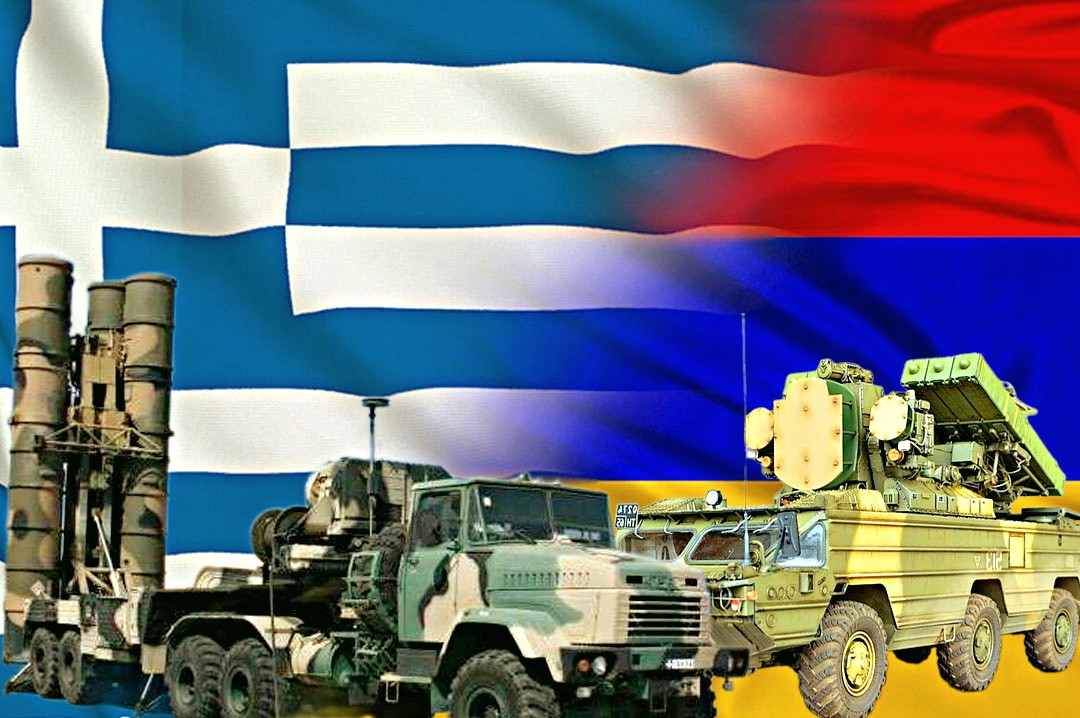When national ambitions, historical grievances, and strategic maneuvering converge, geopolitics becomes a high-stakes chessboard where every move reverberates far beyond regional borders. Greece’s decision to transfer Russian-made S-300, Tor-M1, and Osa-AKM air defense systems to Armenia is a striking gambit that has added new tension to an already volatile region. This move implicates NATO, Russia, Azerbaijan, and Türkiye, altering the strategic dynamics in the South Caucasus and the Eastern Mediterranean.
Greece’s Play: Beyond the Türkiye Question
Upgrading its arsenal with cutting-edge Western systems like Israel’s David’s Sling and Spyder, Greece is shedding obsolete Soviet-era equipment. Handing over these systems to Armenia is a two-pronged move: it clears out old stock while boosting an ally in a region critical to Turkey’s geopolitical calculus.
This isn’t just about military logistics; it’s also a bold diplomatic signal. By arming Armenia, Greece reinforces its ties with Western allies, signaling its alignment with NATO’s evolving priorities while sending a clear message to Ankara. Armenia, a natural counterweight to Türkiye in the Caucasus, becomes a proxy in Greece’s broader strategy to contain Turkish influence.
Armenia’s Security Gamble: Betting on Alliances
For Armenia, still reeling from its defeat in the Second Karabakh War, Greece and France represent lifelines in an increasingly precarious security landscape. The alliance forming between Athens, Paris, and Yerevan is built on a shared interest in countering Türkiye's regional clout. For Armenia, this partnership offers more than just military aid—it’s a political endorsement that bolsters its standing in European circles.
The weapon transfer wouldn’t have happened without France’s active support. Paris, long critical of Türkiye's ambitions, sees in Armenia an opportunity to expand its influence in the Caucasus. This comes at a time when Europe is uneasy about Ankara’s deepening ties with Moscow, making Armenia’s militarization a convenient tool in the West’s efforts to balance Türkiye's regional heft.
For Brussels and Paris, Armenia’s remilitarization fits into a broader strategy to curb Turkish expansionism. This is geopolitics played with a long lens: Armenia becomes a pawn in the West’s bid to check Türkiye's ambitions, even if it risks escalating tensions with Azerbaijan and destabilizing the region further.
The Regional Domino Effect: Türkiye and Azerbaijan Respond
This move sets the stage for a sharp response from Türkiye and Azerbaijan. For Türkiye, Greece’s actions are an extension of their Mediterranean rivalry, now spilling into the Caucasus. Ankara, a key player in NATO and a close ally of Baku, is unlikely to sit idle. It will almost certainly double down on its support for Azerbaijan, strengthening their joint military capabilities and expanding its footprint in the region.
For Azerbaijan, the transfer of weapons to Armenia is a red flag. Baku’s decisive victory in 2020 solidified its dominance in the region, but any enhancement of Armenia’s military potential challenges that balance. With superior technology, including advanced drones and cutting-edge air defense systems, Azerbaijan remains well-positioned to counter Armenia’s aging systems like the S-300. However, this development underscores the need for Baku to remain vigilant and proactive in its military strategy.
NATO’s Balancing Act: Unity Under Strain
Greece’s actions also expose cracks in NATO’s facade of unity. While Athens is a member of the alliance, its transfer of Russian-made systems to Armenia raises eyebrows within NATO, especially given the bloc’s broader strategy to isolate Moscow’s influence. The re-export of Russian systems without Moscow’s consent sets a risky precedent, one that could complicate NATO’s ability to present a united front.
Ankara, as NATO’s eastern anchor, adds another layer of complexity. With one of the largest and most capable militaries in the alliance, Türkiye is a critical player whose grievances against Greece could strain intra-NATO relations. Athens’ move may provide Ankara with fresh ammunition in its ongoing disputes with both NATO and Brussels, potentially leveraging this situation to secure concessions or bolster its standing within the alliance.
Temporary Leverage or Strategic Misstep?
The weapon transfer represents a short-term maneuver with limited practical impact on the battlefield. The systems in question, relics of the Cold War, are ill-suited to counter the advanced technologies that dominate modern warfare. For Armenia, these weapons offer little more than a psychological boost and a temporary patch for its depleted defenses.
For Greece and France, however, the play is about more than military gains. It’s a geopolitical statement, an attempt to redefine alliances and exert pressure on Türkiye in multiple theaters. But the long-term consequences remain uncertain. The move risks further entrenching divisions between East and West, while adding volatility to an already fragile region.
The Bigger Picture: A Chessboard in Flux
The South Caucasus remains a critical pivot in the global balance of power. The Paris-Athens-Yerevan axis may temporarily tip the scales, but it also underscores the enduring complexity of the region’s geopolitical landscape. For Türkiye and Azerbaijan, the challenge lies in crafting a response that preserves their strategic interests without overplaying their hand. For NATO, this episode is a test of its ability to reconcile competing priorities within its ranks.
As the chess game unfolds, one thing is clear: the South Caucasus is far from a "frozen conflict." It’s a dynamic and increasingly crowded theater where every move matters—and missteps could have far-reaching consequences. The divide between East and West is deepening, with no endgame in sight.
A Challenge for NATO: Testing Alliance Unity
Greece’s decision to transfer Russian-made military systems to Armenia strikes at the heart of NATO’s strategic cohesion. While Athens remains a full-fledged member of the alliance, this move raises serious questions about its adherence to NATO protocols and shared commitments. The transfer of Russian equipment without Moscow’s approval not only violates established norms but also sets a precedent that could fracture the alliance’s fragile unity.
Moscow has already voiced its objections, citing international agreements prohibiting the re-export of military systems without the consent of the original manufacturer. NATO’s subdued response reflects the bloc’s internal challenges in managing dissent among its members. Similar discord was evident during earlier debates over the provision of air defense systems to Ukraine, further highlighting the alliance’s struggle to maintain a unified stance in the face of diverging member interests.
This issue takes on heightened significance against the backdrop of Türkiye's growing influence within NATO. As one of the alliance’s most formidable military powers, Ankara is likely to escalate its grievances against Athens, leveraging this incident in the broader context of Greek-Turkish tensions. For NATO, balancing these competing interests will be a critical test of its ability to sustain unity in an increasingly complex geopolitical environment.
Militarization of Armenia: Risks and Consequences
The renewed push to arm Armenia, spearheaded by Greece and France, carries significant risks for regional stability. While the transfer of aging air defense systems like the S-300 provides Yerevan with a short-term boost to its defensive capabilities, the long-term strategic impact remains limited. These systems, designed for conflicts of the past century, are unlikely to shift the regional balance of power dominated by Azerbaijan and Türkiye's modernized military forces.
The remilitarization of Armenia also risks fueling revanchist sentiments within its political establishment. Such a shift could further complicate peace negotiations with Azerbaijan, as the prospect of a militarily empowered Yerevan may embolden hardline elements.
The most pressing danger, however, lies in the potential for escalation. Azerbaijan and Türkiye, equipped with superior technology and robust military infrastructure, are poised to respond decisively to any perceived aggression from Armenia. This dynamic raises the specter of renewed conflict in the South Caucasus, which could draw in external powers and destabilize the region further.
A New Game in the South Caucasus
Greece’s transfer of Russian air defense systems to Armenia has become a flashpoint in a broader geopolitical contest. For Athens, the move is a calculated effort to pressure Türkiye while signaling its strategic intent to NATO and the EU. France, on the other hand, views the maneuver as part of its broader goal to counterbalance Türkiye's growing influence in the region, leveraging Armenia as a critical ally in this effort.
For Armenia, this partnership provides a temporary lifeline, allowing it to shore up its defenses after the devastating losses in the Second Karabakh War. Yet for Azerbaijan and Türkiye, the move is a direct provocation—one that demands immediate countermeasures. This development underscores the volatile nature of the South Caucasus, where local disputes are inextricably tied to global power dynamics.
The broader question remains: will this region become the stage for the next great geopolitical escalation, or will it settle into the uneasy stasis of yet another “frozen conflict”? What is certain is that the divide between East and West continues to widen, with the South Caucasus positioned squarely at its center. As this high-stakes chess game unfolds, the only constant is the region’s growing importance in the global struggle for influence.







